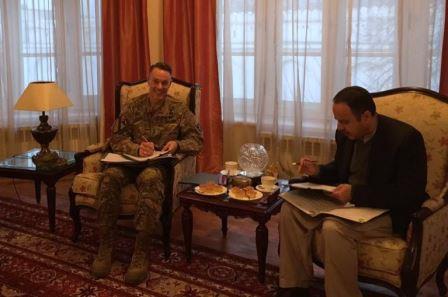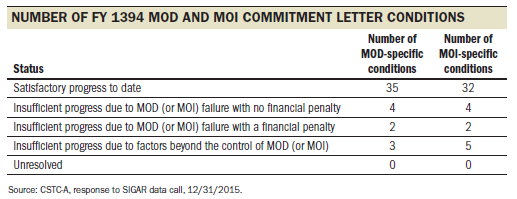 |
 |
|
Menu HomeAfghan ReportDaily ReadKabul NEOMapsGlossarySite MapAdsThis website is an Amazon Associate and earns money for qualifying purchases.
(SidebarLeftAds) |
Commitment LettersThe Combined Security Transition Command - Afghanistan (CSTC-A) has ". . . significantly increased its budgetary controls through the Commitment Letters signed with the Ministry of Defense (MoD), Ministry of Interior (MoI), and the Ministry of Finance (MoF). These agreements enhance transparency, accountability and oversight of international donations by requiring the implementation of transparency measures such as published spend plans, contractor vetting and audits." 1.
A passage from an October 2015 press release by MG Todd T. Semonite, a former commander of the Combined Security Transition Command - Afghanistan (CSTC-A) provides some clarity on the purpose and scope of the commitment letters 2. "Annually, CSTC-A and the ANDSF mutually draft and sign commitment letters that establish conditions the Afghan government must meet in order to receive funding, equipment or infrastructure. This year leaders from the Ministry of Defense, Ministry of Interior and the Ministry of Finance signed the letter, obligating their organizations to meet 93 (45 MoD/48 MoI) mutually agreed-upon goals. These goals drive Afghan government processes and save millions of dollars in donor contributions by reducing fuel and ammunition excess (by 40 and 60 percent, respectively), addressing corruption at multiple levels, and setting procedures that reduce fraud and abuse opportunities. It is the commitment letters that enable CSTC-A the leverage to hold or debit funds and drive fiscally responsible behavior. As we look forward to 2016 the letters will be more detailed and ask even more of the Afghan government." CSTC-A is attempting, through the use of commitment letters, to provide performance incentives and apply penalties (call it carrot and stick) that will prompt the MoD and MoI to show "demonstrable improvement in their capacity and capability in personnel management, resource management and procurement, and logistics and maintenance, with an overall goal of sustainability over the long-term". 3. The letters establish expectations for the responsible management of a variety of international funds to include the Afghan Security Forces Fund (ASFF), the NATO ANA Trust Fund, and the United Nations Development Program (UNDP) LOFTA. In addition, the CSTC-A commitment letters also identify various legal constraints, such as the Berry Amendment and the Leahy Law on U.S. funding. The chart below provides insight into the number of 'conditions' associated with the commitment letters and how many of the conditions have been met by MoI and MoD.
|
Books about AfghanistanAll external sites open up in a new window. |
|


